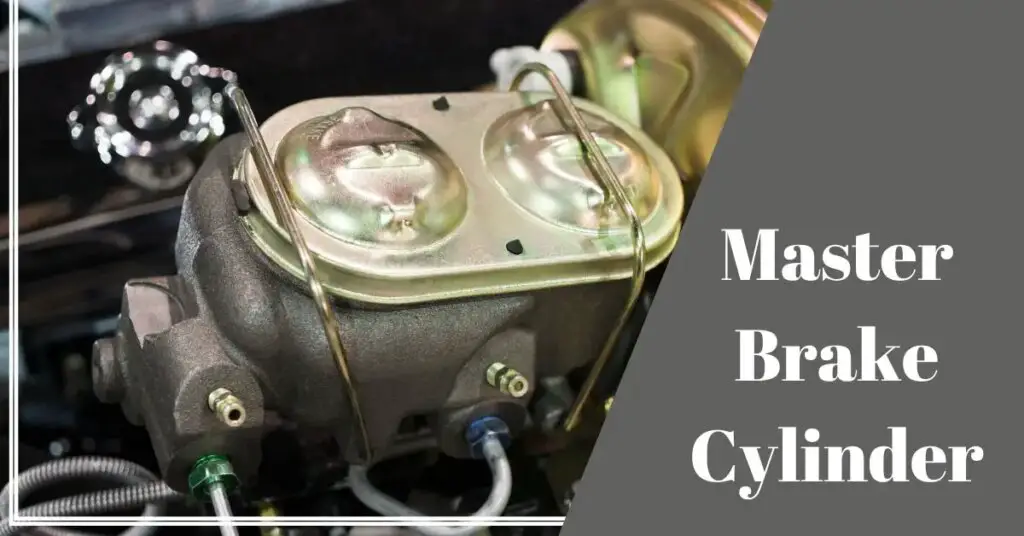Are you having trouble with the master brake cylinder? When it comes to automotive safety, the braking system plays a critical role. One of the key components responsible for ensuring smooth and efficient braking is the master brake cylinder.
In this article, we will delve into the workings of the master brake cylinder, its importance in your vehicle’s braking system, and why regular maintenance is essential to ensure optimal performance.
Table of Contents
What is a Master Brake Cylinder?
The master brake cylinder is crucial to a vehicle’s braking system. It plays a vital role in helping you stop your car safely. Imagine it as the heart of the brake system, pumping the necessary pressure to apply the brakes.
Pressing the brake pedal with your foot pushes a piston inside the brake master cylinder. This creates hydraulic pressure in the brake fluid, like special oil that transfers force. The pressure then travels through brake lines to the wheels.
At each wheel, brake calipers or drums use the hydraulic pressure to squeeze the brake pads or shoes against the spinning discs or drums. This contact creates friction, slowing down or stopping the wheels and, ultimately, the vehicle.
The master brake cylinder is crucial because it ensures that the right amount of pressure reaches each brake, allowing your car to stop evenly and safely. If the master brake cylinder fails or has problems, it can lead to brake failure, making it difficult to stop the car properly, which is very dangerous.
How Does a Master Brake Cylinder Work?
Before going into detail about how the brake master cylinder works, we need to understand what hydraulic force is and the components of the system.
Hydraulic Brake System
The hydraulic brake system is a type of braking system that uses brake fluid to transfer force from the brake pedal to the brakes at the wheels. Pressing the brake pedal activates the master brake cylinder, which then generates hydraulic pressure in the brake fluid. This pressure is transmitted through brake lines to each wheel, where it’s converted into mechanical force to apply the brakes.
Master Brake Cylinder’s Design and Components
The brake master cylinder is usually located under the vehicle’s hood, close to the firewall, and is connected to the brake pedal. It consists of several important components:
- Brake Pedal: The brake pedal is the part inside the car that you press with your foot when you want to slow down or stop.
- Pushrod: When you press the brake pedal, it pushes on a small rod called the pushrod, transmitting the force to the master brake cylinder.
- Master Cylinder Body: This is the main housing of the master brake cylinder and contains the other components.
- Primary Piston: The pushrod exerts force on the primary piston, which is a movable component inside the master cylinder. When the pushrod moves forward, it pushes the primary piston.
- Secondary Piston: Inside the primary piston, there’s a smaller piston called the secondary piston. When you press the brake pedal, the primary piston moves forward, pushing the secondary piston as well.
- Brake Fluid Reservoir: The master cylinder has a reservoir that holds brake fluid. It’s usually on top of the master cylinder and keeps the brake system supplied with fluid as needed.
- Fluid Inlets and Outlets: The master cylinder has inlets and outlets where the brake fluid flows in and out.
How It Works
When you press the brake pedal, the pushrod applies force to the primary piston in the master cylinder. As the primary piston moves forward, it also pushes the secondary piston. This action generates hydraulic pressure in the brake fluid inside the master cylinder.
The hydraulic pressure is then sent to each wheel’s brake caliper or drum through brake lines. Modern cars usually have two separate hydraulic circuits within the master cylinder, providing a safety feature. If one circuit fails, the other can still operate some of the brakes, helping you maintain some stopping power.
At each wheel, the brake caliper or drum uses hydraulic pressure to engage the brake pads or shoes against the brake discs or drums, creating friction that slows down the wheels and the vehicle.
When you release the brake pedal, springs in the master cylinder and brakes return the pistons to their original positions, and the brake fluid returns to the reservoir.
In summary, the master brake cylinder works by converting the force from the brake pedal into hydraulic pressure. This pressure is then used to apply the brakes, allowing you to slow down or stop your vehicle safely and efficiently.
You can check out this video for details!!!
Types of Master Brake Cylinders
Single Circuit Master Brake Cylinder
In older vehicles, you may find a single-circuit master brake cylinder. This type of cylinder operates all the brakes simultaneously, which means the entire braking capacity is compromised if there’s a failure in one part of the system.
Pros of Single Circuit Master Brake Cylinder:
- Simplicity and Cost-Effectiveness: Single-circuit master brake cylinders are relatively simple in design and construction, making them more affordable to manufacture and maintain.
- Predictable Brake Response: With a single circuit system, the brake response tends to be more predictable since all four wheels simultaneously receive the same amount of pressure when the brake pedal is pressed.
- Compact Size: Single circuit master cylinders are typically smaller and take up less space in the vehicle’s engine compartment.
- Easy Diagnostics: When an issue arises, troubleshooting and diagnosing problems in a single-circuit system are generally easier compared to complex dual-circuit systems.
Cons of Single Circuit Master Brake Cylinder:
- Safety Concerns: The main drawback of a single circuit master cylinder is safety. If a brake system fails, such as a leak in the brake line or a component malfunction, the entire braking system may be affected, leading to a complete loss of braking power.
- Uneven Braking: In case of a failure, the braking force is lost to all wheels simultaneously, potentially leading to uneven braking and reduced control of the vehicle.
- Brake Fade: Single circuit systems are more susceptible to brake fade, especially in demanding braking situations, as the heat generated during prolonged braking can affect the brake fluid and reduce its efficiency.
Dual Circuit Master Brake Cylinder
Modern vehicles are equipped with dual circuit brake master cylinders. These have two separate hydraulic circuits, each responsible for braking two wheels. If one circuit fails, the other remains functional, providing some level of braking capacity.
Pros of Dual Circuit Master Brake Cylinder:
- Enhanced Safety: The primary advantage of a dual circuit master brake cylinder is its enhanced safety. It has two separate hydraulic circuits that operate independently. If one circuit fails, the other circuit can still provide partial braking power, reducing the risk of a complete loss of braking ability.
- Redundancy: The dual circuit design offers redundancy, meaning that even if one circuit fails, the other circuit can take over, providing a backup system for increased reliability.
- Even Braking Distribution: Dual circuit systems allow for a more even distribution of braking force to all four wheels. This can improve braking performance and stability, especially during emergency braking situations.
- Reduced Brake Fade: Dual circuits help reduce the risk of brake fade during prolonged or demanding braking, as the workload is distributed between the two circuits.
- Compatibility with Antilock Braking Systems (ABS): Dual circuit master cylinders are often used in vehicles equipped with ABS. ABS relies on independent control of each wheel’s brake to prevent skidding and improve control during braking.
Cons of Dual Circuit Master Cylinder Brake:
- Complexity and Cost: Dual circuit master brake cylinders are more complex in design and construction compared to single circuit ones. As a result, they tend to be more expensive to manufacture and maintain.
- Increased Diagnostics Complexity: Troubleshooting and diagnosing problems in a dual circuit system can be more challenging due to the presence of multiple circuits and components.
Signs of a Failing Master Brake Cylinder

A failing master brake cylinder can lead to significant safety concerns. Here are some common signs that indicate a malfunctioning master brake cylinder:
#1 Spongy Brake Pedal
If you notice that the brake pedal feels soft, spongy, or sinks to the floor when you press it, it could be a sign of air or fluid leakage within the master brake cylinder or the brake lines. This can result in reduced braking effectiveness and should be addressed immediately.
#2 Brake Fluid Leaks
Check for any signs of brake fluid leakage around the master cylinder brake or near the wheels. Brake fluid is essential for the hydraulic braking system, and any leakage can lead to a loss of pressure and compromise the brake’s ability to stop the vehicle.
#3 Low Brake Fluid Level
If you find that the brake fluid reservoir consistently has low levels of fluid, it may indicate a leak or a failing master brake cylinder. Low brake fluid levels can lead to air entering the system, causing spongy brakes and reduced braking performance.
#4 Illuminated Brake Warning Light
Many modern vehicles are equipped with a dashboard warning light that indicates potential brake system issues. If the brake warning light illuminates, it’s essential to have the brake system inspected promptly to identify the problem.
#5 Brake Pedal Vibration
A failing master brake cylinder can cause brake pedal vibrations or pulsations when applying the brakes. This may be a sign of uneven pressure distribution within the braking system.
#6 Inconsistent Braking Response
You may experience inconsistent or unpredictable braking performance when pressing the brake pedal. This could range from the brakes feeling overly sensitive to requiring more effort than usual to stop the vehicle.
#7 Brake Fluid Contamination
Inspect the brake fluid for signs of contamination, such as a dark or murky appearance. Contaminated brake fluid can lead to corrosion and damage to the master brake cylinder and other brake components.
#8 Brake Drag
If the brakes don’t fully release after releasing the brake pedal, causing the vehicle to drag or feel sluggish, it could indicate a problem with the brake master cylinder or the brake calipers.
How To Diagnose Master Brake Cylinder Problems
Diagnosing issues with the master brake cylinder requires careful observation and the right tools. Here’s a step-by-step guide to help you through the diagnostic process, along with the necessary tools and safety precautions:

Tools Needed:
- Jack and jack stands (for elevating the vehicle safely)
- Wrench set and pliers
- Brake fluid test strips or a brake fluid tester
- Brake fluid (if needed for topping up)
- Brake system bleeding kit (if air needs to be removed from the system)
- Safety goggles and gloves
- Flashlight (for better visibility under the vehicle)
Step-by-Step Diagnosis:
- Inspect Brake Fluid Reservoir: Check the brake fluid reservoir’s level and condition. Ensure it’s filled to the recommended level and the fluid is clean and contamination-free.
- Look for Leaks: Check around the master cylinder brake and along the brake lines for any signs of brake fluid leaks. Leaks may indicate a failing master brake cylinder or other brake system issues.
- Test Brake Pedal Feel: Press the brake pedal multiple times with the engine off. If the pedal feels spongy or sinks to the floor, it could indicate air in the system or a failing master brake cylinder.
- Brake Fluid Test: Use brake fluid test strips or a brake fluid tester to check the fluid’s moisture content. Contaminated brake fluid can lead to corrosion and damage to the master brake cylinder.
- Brake Bleeding: If the pedal feels spongy, bleeding the brake system might help remove air bubbles and improve brake performance. Bleeding should be done following the manufacturer’s recommended procedure.
- Check Brake Lines and Hoses: Examine the brake lines and hoses for any signs of wear, damage, or corrosion. Damaged lines or hoses can lead to fluid leaks and brake system issues.
- Inspect Brake Calipers and Wheel Cylinders: Check the brake calipers (or wheel cylinders in drum brakes) for signs of leakage or malfunction. Faulty calipers or wheel cylinders can cause uneven braking.
- Test Brake Warning Light: Turn on the ignition (without starting the engine) and check if the brake warning light illuminates. If it doesn’t light up briefly during startup, there may be an issue with the warning light circuit.
- Test the Brakes: Take the vehicle for a test drive in a safe area and pay attention to how the brakes feel and respond. Note any unusual noises or behaviors.
Regular Maintenance Of Master Cylinder Brake
Regular brake system maintenance is of utmost importance for various reasons, such as:
- Safety
- Keeps the brake system in optimal condition
- Preventing costly repairs
- Prolonging brake system life
Here are some essential steps to help you maintain the master brake cylinder:
Brake Fluid Flush
Regularly flushing and replacing brake fluid is crucial for maintaining the efficiency of the master brake cylinder and the entire braking system.
Check Brake Fluid Quality
Inspect the quality of the brake fluid regularly. Brake fluid absorbs moisture over time, which can lead to reduced braking performance and damage to the master cylinder. If the brake fluid appears contaminated or discolored, replacing it following the manufacturer’s recommended interval is essential.
Brake Fluid Replacement

Replace the brake fluid periodically, as recommended by your vehicle’s manufacturer. Flushing and replacing the brake fluid help maintain its integrity and prevent moisture buildup, ensuring proper function of the master cylinder and other brake components.
Bleed the Brake System
You may need to bleed the brake system if you notice a spongy brake pedal or air in the brake lines. Bleeding removes air bubbles from the system, enhancing brake performance and preventing potential issues with the master brake cylinder.
Address Brake Fluid Leaks Promptly
If you notice any brake fluid leaks around the master cylinder brake or any brake lines, have them repaired immediately. Brake fluid leaks can lead to a loss of hydraulic pressure, compromising the brake system’s effectiveness.
Use Recommended Brake Fluid
Always use the brake fluid recommended by your vehicle’s manufacturer. Using the correct type of brake fluid ensures compatibility with the master brake cylinder and other brake components, preventing potential damage.
Master Brake Cylinder Replacement
When is master brake cylinder replacement necessary?
Replacing the master cylinder brake becomes necessary when you observe any of the following signs:
- Spongy or soft brake pedal.
- Brake fluid leaks around the master cylinder.
- Brake fluid contamination or discoloration.
- Low brake fluid level despite no apparent leaks.
- Brake warning light illumination.
- Inconsistent or unpredictable braking response.
- Brake pedal sinking to the floor when pressed.
- Noticeable loss of braking power.
- Master cylinder is damaged or corroded.
If you encounter any of these issues, it’s essential to have your master brake cylinder inspected by a qualified mechanic to confirm the need for replacement.
How do you replace the master brake cylinder yourself?
Please note that replacing the master brake cylinder is a complex task that requires advanced mechanical knowledge. If you’re not experienced with automotive repairs, having a professional mechanic perform the replacement is best. However, here’s a general outline of the process:
Gather Necessary Tools and Supplies:
- New brake master cylinder (ensure it’s compatible with your vehicle).
- Brake fluid (to refill the system).
- Wrench set.
- Pliers.
- Brake bleeding kit (to remove air from the system).
Preparation:
- Park the vehicle on a level surface and engage the parking brake.
- Lift the vehicle using a jack and secure it on jack stands for safety.
Step-by-step Instructions
Step 1: Drain Brake Fluid
Open the brake fluid reservoir and drain the brake fluid into a suitable container.
Step 2: Disconnect Brake Lines
Carefully disconnect the brake lines from the old master cylinder. Be cautious not to damage the lines or fittings.
Step 3: Remove the Master Cylinder
Loosen and remove the bolts securing the master cylinder to the brake booster or firewall.
Gently pull out the old master cylinder, being cautious not to spill brake fluid.
Step 4: Install the New Master Cylinder
Place the new master cylinder brake in position.
Reinstall and tighten the bolts to secure the new cylinder.
Step 5: Reconnect Brake Lines
Attach the brake lines to the appropriate ports on the new master cylinder.
Ensure the connections are tight and leak-free.
Step 6: Refill Brake Fluid
Refill the brake fluid reservoir with fresh, recommended brake fluid.
Step 7: Bleed the Brake System
Use a brake bleeding kit to remove air from the system.
Bleed the brakes at each wheel until a steady stream of brake fluid is obtained, starting from the wheel farthest from the master cylinder and working towards the nearest.
Step 8: Final Inspection
Check for any leaks around the new master cylinder and brake lines.
Test the brake pedal for proper feel and responsiveness.
You can check out this video for detail:
How much does the master cylinder brake replacement cost?
The cost of a master brake cylinder replacement can vary depending on several factors, including the make and model of your vehicle, the brand of the replacement cylinder, and labor costs in your area.
On average, the cost of a master brake cylinder replacement can range from $150 to $400.
Here’s a breakdown of the main cost components:
- Master Brake Cylinder: The price of the replacement master brake cylinder can vary depending on whether you choose an Original Equipment Manufacturer (OEM) part or an aftermarket option. OEM parts tend to be more expensive, but they are designed specifically for your vehicle’s make and model, offering higher compatibility and reliability.
- Labor Costs: The labor costs for replacing the master brake cylinder can vary depending on the complexity of the job and the labor rates of the auto repair shop you choose. The replacement process can be relatively straightforward or more involved, depending on the vehicle’s design and location of the master cylinder.
- Additional Parts and Services: Sometimes, other components may need to be replaced or serviced during the master brake cylinder replacement, such as brake lines, brake fluid, or seals. These additional parts and services can add to the overall cost.
- Location: Labor rates can differ significantly depending on your location. Auto repair shops in urban areas or regions with higher living costs may charge more for labor compared to shops in rural or lower-cost areas.
Frequently Asked Questions
What is the typical lifespan of a master brake cylinder?
The lifespan of a master brake cylinder varies depending on driving conditions, maintenance, and vehicle usage. On average, it can last anywhere between 50,000 to 100,000 miles.
Can I drive my car with a faulty master brake cylinder?
Driving with a faulty master brake cylinder is dangerous and not recommended. It can lead to a loss of braking power and compromise your ability to stop the vehicle safely.
How much does it cost to replace a master brake cylinder?
The cost of replacing a master brake cylinder can vary depending on the make and model of your vehicle, but it typically ranges from $200 to $500, including parts and labor.
What are the symptoms of air in the brake master cylinder?
Air in the brake master cylinder can lead to a spongy or soft brake pedal, as air compresses more than brake fluid. This can result in reduced braking efficiency, longer stopping distances, and a less responsive brake pedal. You may also notice a hissing or squishy sound when you press the brake pedal, indicating the presence of air in the system. If you experience any of these symptoms, it’s crucial to have the brake system inspected and bled to remove the air and restore proper braking performance.
Can the master brake cylinder cause my brakes to lock up?
While the master brake cylinder is not the primary cause of brakes locking up, a faulty master brake cylinder can lead to uneven pressure distribution in the braking system, resulting in brake lock-up in extreme cases. Regular maintenance and timely repairs can help prevent such issues.
Can a brake master cylinder be repaired, or does it always need replacement?
In some cases, the master brake cylinder can be repaired, especially if the issue is minor, such as a leaking seal. However, more severe damage often requires replacement. It’s best to consult a qualified mechanic to assess the extent of the damage and recommend the appropriate solution.
Why is it important to use the correct type of brake fluid?
Using the correct type of brake fluid specified by your vehicle’s manufacturer is crucial for maintaining the integrity of the braking system. Different brake fluids have varying properties, such as boiling points and viscosity, and using the wrong type can result in brake fluid leaks, reduced braking performance, and potential damage to the master brake cylinder and other brake components.
Can a master brake cylinder be upgraded for better performance?
Yes, upgrading to a higher-performance brake master cylinder can improve brake pedal feel and responsiveness, especially for enthusiasts or those with specific driving needs. However, it’s essential to ensure that the upgraded master cylinder is compatible with your vehicle and that the entire braking system is appropriately calibrated for optimal performance.
How often should I have my master brake cylinder inspected?
It’s recommended to have your master brake cylinder inspected during routine maintenance intervals or whenever you notice signs of brake-related issues. Regular inspections can help identify potential problems early on and prevent more extensive and costly repairs down the line.
Conclusion
The master brake cylinder is a critical component of your vehicle’s braking system, and its proper functioning is essential for your safety on the road. Understanding its role, signs of failure, and the significance of regular maintenance empowers you to take better care of your brakes. Remember, a well-maintained master brake cylinder can make a life-saving difference in emergency braking situations.
Hi there! I’m Naomi O’Colman. I’ve got years of experience working at an auto repair shop here in Texas under my belt. On top of that, ever since I was a kid I’ve been passionate about the auto industry. Since I’ve joined the team at automotivegearz.com I’ve been enthusiastically sharing my passion and insights with my readers. I’m dedicated to delivering high quality content and helping you stay up to date with the latest automotive trends and products out there!







